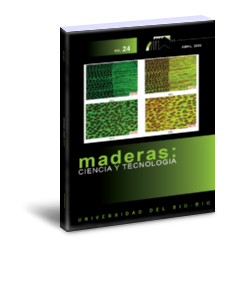Mass transfer properties of Acacia mangium plantation wood
DOI:
https://doi.org/10.4067/s0718-221x2022000100402Keywords:
Acacia mangium, anisotropy, diffusivity, mass transfer, permeabilityAbstract
This study investigated the mass transfer properties (permeability and mass diffusivity) in the longitudinal, radial and tangential directions of plantation-grown Acacia mangium in Vinh Phuc province, northeast, Vietnam. These properties will be used to complement a conventional drying model in the future. Measurements of gas and liquid permeability were performed using a Porometer (POROLUXTM1000). Mass diffusivity was determined in a constant humidity and temperature chamber using PVC-CHA vaporimeters. Results showed the gas permeability was significant higher than liquid with the descending order of longitudinal, radial, and tangential directions. The permeability anisotropy ratios from the longitudinal to transverse directions of Acacia mangium were much lower than other published species. However, the obvious anisotropy ratios from radial to tangential for both permeability and diffusivity, is one of concerns as they can exacerbate defects during drying. Besides, the high permeability and diffusivity of Acacia mangium compared to some other species reported compounds its relatively fast drying rate.
Downloads
References
Agoua, E.; Perré, P. 2010. Mass transfer in wood: Identification of structural parameters fromdiffusivity and permeability measurements. J Porous Media 13(11): 1017-1024. http://doi.org/10.1615/JPorMedia.v13.i11.80.
Booker, R.E. 1977. Problems in the measurement of longitudinal sapwood permeability and hydraulic conductivity. NZ J Forestry Sci 7(3): 297-306. http://www.scionresearch.com/__data/assets/pdf_file/0003/37479/NZJFS731977BOOKER297-306.pdf/.
De Jong, W.; Sam, D.D.; Hung, T.V. 2006. Forest Rehabilitation in Vietnam Histories, realities and future. Center for International Forestry Research (CIFOR). Bogor, Indonesia. http://www.cifor.org/publications/pdf_files/Books/BDeJong0601.pdf.
Hansmann, C.; Gindl, W.; Wimmer, R.; Teischinger, A. 2002. Permeability of wood - A review. Wood Res-Slovakia 47(4): 1-16. http://www.academia.edu/27225462/Permeability_of_wood_-_a_review.
Haque, M.N. 2002. Modelling of solar kilns and the development of an optimised schedule for drying hardwood timber. Ph.D. Thesis, University of Sydney. Sydney, Australia. http://ses.library.usyd.edu.au/handle/2123/581/.
Harwood, C.E.; Nambiar, S.E.K. 2014. Sustainable plantation forestry in South-East Asia. Australian Centre for International Agricultural Research (ACIAR). Canberra, Australia. http://aciar.gov.au/node/12221.
Leggate, W.; Redman, A.L.; Wood, J.; Baillères, H.; Lee, D.J. 2019. Radial Permeability of the Hybrid Pine (Pinus elliottii × Pinus caribaea) in Australia. Bioresources 14(2): 4358-4372. http://bioresources.cnr.ncsu.edu/resources/radial-permeability-of-the-hybrid-pine-pinus-elliottii-x-pinus-caribaea-in-australia.
Milota, M.R.; Tschernitz, J.L.; Verrill, S.P.; Mianowski, T. 1995. Gas permeability of plantation loblolly pine. Wood Fiber Sci 27(1): 34-40. http://wfs.swst.org/index.php/wfs/article/view/249.
Phonetip, K. 2018. Investigating optimized drying methods for Eucalyptus delegatensis using a solar kiln. Ph.D. Thesis, University of Melbourne. Melbourne, Australia. http://hdl.handle.net/11343/212529.
Redman, A.L.; Baillères, H.; Perré, P.; Carr, E.; Turner, I.W. 2017. A relevant and robust vacuum-drying model applied to hardwoods. Wood Sci Technol 51: 701–719. http://doi.org/10.1007/s00226-017-0908-7.
Redman, A.L.; Baillères, H.; Turner, I.W.; Perré, P. 2012. Mass transfer properties (permeability and mass diffusivity) of four australian hardwood species. Bioresources 7(3): 3410-3424. http://ojs.cnr.ncsu.edu/index.php/BioRes/article/view/BioRes_07_3_3410_Redman_Mass_Transfer_Properties_Australian_Hardwood.
Taghiyari, H.R. 2012. Correlation between gas and liquid permeability in some nanosilver-impregnated and untreated hardwood. J Trop For Sci 24(2): 249-255. https://www.frim.gov.my/v1/JTFSOnline/jtfs/v24n2/249-255.pdf.
Tagne, M.S.; Rémond, R.; Rogaume, Y.; Zoulalian, A.; Perré, P. 2016. Characterization of sorption behavior and mass transfer properties of four central Africa tropical woods: Ayous, Sapele, Frake, Lotofa. Maderas-Cienc Tecnol 18(1): 207-226. http://doi.org/10.4067/s0718-221x2016005000020.
Tuan, H.C. 2014. Announced the current status of national forest in 2013, M.o.A.a.R.D. (MARD) (ed.). (Decision no. 3322/QD-BNN-TCLN), Hanoi, Vietman. http://tongcuclamnghiep.gov.vn/Media/AuflaNews/Attachment/3322_Q%C4%90-BNN_TCLN.pdf.
Tuan, H.C. 2020. Announced the current status of national forest in 2019, M.o.A.a.R.D. (MARD) (ed.). (Decision no. 1423/QD-BNN-TCLN), Hanoi, Vietman. http://tongcuclamnghiep.gov.vn/content/uploads/files/Hie%CC%A3%CC%82n%20tra%CC%A3ng%20ru%CC%9B%CC%80ng%202019.pdf.
Yuniarti, K.; Brodie, G.; Ozarska, B.; Harris, G.; Waugh, G. 2018. A mathematical model for moisture movement during continous and intermittent drying of Eucalyptus saligna. EUR J Wood Wood Prod 76: 1165–1172. http://doi.org/10.1007/s00107-018-1296-x.
Zohoun, S.; Agoua, E.; Degan, G.; Perré, P. 2003. An experimental correction proposed for an accurate determination of mass diffusivity of wood in steady regime. Heat Mass Transfer 39: 147-155. http://doi.org/10.1007/s00231-002-0324-9.
Downloads
Published
How to Cite
Issue
Section
License

This work is licensed under a Creative Commons Attribution 4.0 International License.
Los autores/as conservarán sus derechos de autor y garantizarán a la revista el derecho de primera publicación de su obra, el cuál estará simultáneamente sujeto a la Licencia de Reconocimiento de Creative Commons CC-BY que permite a terceros compartir la obra siempre que se indique su autor y su primera publicación esta revista.































